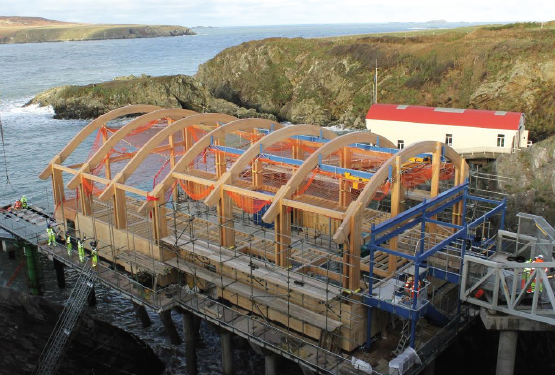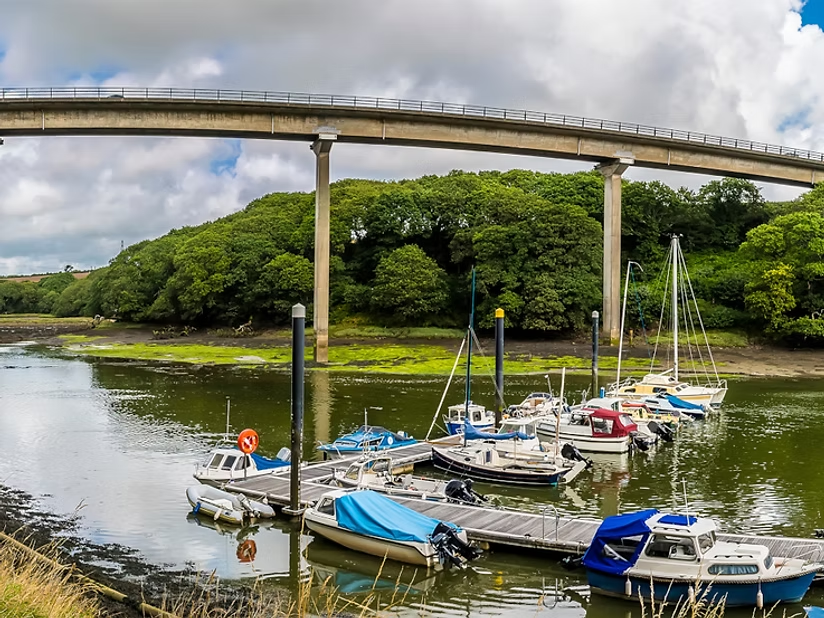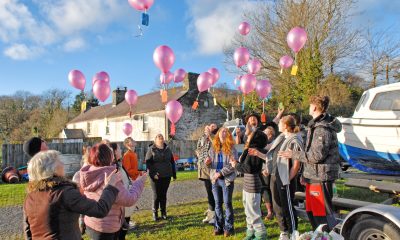News
£10m Lifeboat Station months from completion


St Davids’ new station (foreground): And old station (background)
ST DAVIDS’ RNLI new Lifeboat Station at St Justinian’s head is now only months away from being completed. Held up by a windy Winter, momentum is building.
The city currently has two stations and operate two All-weather life boats the Tyne-Class and their new Tamar-class lifeboat. The oldest of the two stations has been running for 140 years with the most recent for the last century.
Station Coxwain, Dai John, explained that the two lifeboats are currently needed as the new high-tech Tamar vessel, which is currently being modified in Poole, can only be moored up off the coast, which when conditions are exceptionally rough could see the lifeboat become untethered and destroyed on the cliffs.
The current set up for the North County station is to, move the ship into safer harbours further south like Milford Haven and Neyland when bad weather is forecast. To keep the station going 24/7 they were allowed to keep housing the 28-year veteran Tyne class.
The new station will permanently house the Tamar boat as well as many other state-of-the-art facilities. St Davids RNLI was the last of those in Pembrokeshire to receive a newly constructed or upgraded station.
Undertaken by Bam Nuttall, work on the station was started in June 2014, with many members of contracted staff having worked on previous similar jobs across the country with the company.
Site manager Rhodri Jenkins, who tallies St Davids as his 4th station said: “This was one of the more awkward sites to work on, we’ve had to squeeze the station into a very narrow space.”
Rhodri used the cliff line as an example showing the sheeted rock. he explained: “That sort of rock can easily collapse or slide, so we had to put up this netting and cross-anchor the rock to prevent it happening.”
The site has already had the concrete station foundation stilts laid, the base level put in place and the steel slip stilts bored and placed which are now supporting the extra long slip.
The new slipway, extends further than the current one which will tackle the current issue St Davids’ RNLI faces of retrieving their vessel once launched. Although their current set up and launch 24/7 Dai explained: The issue is once we have returned, at low tide we have to wait a couple of hours before we can winch the boat up.”
The new station has been built with laminated-layered wooden beams which will be exposed upon completion and will last for over 100 years, Rhodri said: “Over the life of the station this style is very cost effective over steel, which others use, that are constantly fighting the elements needing parts cutting out and replaced.”
“With a mixture of the exposed beams and the under floor heating the station will have a very ambient atmosphere.”
The station utilises a method of harnessing sea water to create heat, Rhodri described how the system sucks water through pipework into the station at around 12 degrees with goes through a system which takes maybe four degrees and deposits the 8 degree water back.
“This sustainable heating is an alternative to having a large bore hole to create heat, which is often used.” He said.
The new premises will have full disability access including an internal lift, toilets and a tram system from headland to the front door following the steps.
The station will also join the ranks of few other stations which harbours their in-shore life boat within the same building. With its own indoor garage the in-shore rib, can be lowered to sea level via crane 24/7 to immediately attend incidents within a closer proximity that the all-weather boat needn’t be called out to attend.
Dai noted that all 26 volunteers live within a very short drive of St Justinian’s, which is vital to the rapid response they provide he said: “Our volunteers need to be able to get here in time for launch, which currently is about 10 minutes on the rib and 12 to release the all-weather boat”
According to Dai one of the major benefits will be to the crew facilities for the 28 team members of which two are permanent and 26 are volunteer, he stated: “At the moment we have meeting in the top of the station which has no wall space and is built into the roof so it’s all curved.”
The new design has a large crew designated room which will allow in house training and meetings to take place, he said: “We are lucky that St Davids fire department are letting us use their training room at the moment while we are running day and evening first aid courses.”
Rhodri explained that the whole project at St Davids will cost just shy of £10m by the time it is completed and also said that he expects the usable floor space to be three or four times more than they currently have.
In response to what might happen with the old site, which neighbours the new-build, Dai said: “It was put on the market a little time a go to see if there was any interest, but the future of the station is unclear at the moment.”
The work being done on the new station is heavily dependant on the large crane which is being used to move goods between the mainland and the stilted site, which according to Rhodri has had some trouble with the Winter weather.
Rhodri stated: “The crane cannot operate when winds are 30mph of above so since November lots of the work has been mopping up rather than moving forward.”
“We have been lucky enough to get days where we can move large quantities of what we’re going to need down onto the station which does make up for bad weather that follows.”
Despite the weather, the station’s shape can be already seen, and from the ground floor of the station which will be used solely for crew, the true size of the facility can be appreciated. Rhodri expects completion to be only months away.
Dai said the crew has pencilled in launch tests for June 2016, and they expect the site to be fully transitioned by September this year.
The RNLI rely almost solely on donations from the public as at present only 2% of their total funding comes from government sources.
The work they do has already saved over 140,000 lives nation wide, and the service they provide is made more vital in our county due to Pembrokeshire’s peninsula formation as well as the growing popularity of water sports and the 186mile coastal path.
Dai added: “We are so appreciative of the national and local support for the RNLI, last year we launched a fund raiser in St Davids which had fantastic response.”
For more details on the RNLI, the work they do, and how to donate go to:www.rnli.org
Local Government
Essential bridge maintenance and repairs planned for January

Works on Westfield Pill Bridge to affect A477 traffic
ESSENTIAL maintenance and repair work is set to begin on Westfield Pill Bridge, with traffic management in place on the A477 between Neyland and Pembroke Dock.
The programme of works is due to start on Monday (Jan 19) following a Principal Inspection carried out in 2022, which identified a number of necessary repairs to maintain the long-term durability and safety of the structure.
Westfield Pill Bridge is a key route linking communities in south Pembrokeshire and carries a high volume of daily traffic. While major works were last undertaken in 1998 — which required a full closure of the bridge — the upcoming refurbishment has been designed to avoid shutting the crossing entirely.
Instead, the works, scheduled to take place in early 2026, will be managed through traffic control measures to keep the bridge open throughout the project.
The planned refurbishment will include the replacement of both eastbound and westbound bridge parapets, the renewal of expansion joints, and full resurfacing of the bridge deck.
The work is expected to take no longer than three months and will involve weekend and night-time working to help minimise disruption. All construction activity will be carried out from the bridge deck and has been scheduled to avoid clashes with other planned trunk road works, as well as periods of higher traffic demand.
Two-way traffic signals will be in place for the duration of the works. These will be manually controlled during peak periods, with particular efforts made to reduce delays affecting school transport.
Motorists are advised that there may be delays to local bus services during the works, including the 349 (Haverfordwest–Pembroke Dock–Tenby) and 356 (Milford Haven–Monkton) routes.
Drivers are encouraged to allow extra time for journeys and to follow on-site signage while the works are underway.
Crime
Breakthrough in 1993 Tooze murders: 86-year-old man arrested after cold case review

POLICE investigating one of Wales’ most disturbing unsolved double murders have arrested an 86-year-old man on suspicion of killing elderly couple Harry and Megan Tooze more than three decades ago.
South Wales Police confirmed the arrest on Tuesday (Dec 17), following a forensic cold case review into the 1993 killings, which shocked the rural community of Llanharry and cast a long shadow over the South Wales justice system.
Harry Tooze, aged 64, and his wife Megan, 67, were found shot dead with a shotgun at their isolated Ty Ar y Waun farmhouse on July 26, 1993. Their bodies were discovered inside a cowshed on the property, concealed beneath carpet and hay bales, having been shot in the head at close range.
The brutality of the killings and the remoteness of the scene prompted one of the most high-profile murder investigations in Wales at the time.
Conviction later quashed
In 1995, Cheryl Tooze’s then-boyfriend, Jonathan Jones, was convicted of the murders and sentenced to life imprisonment. The prosecution case rested heavily on a partial fingerprint found on a teacup at the farmhouse.
However, the conviction unravelled just a year later. In 1996, the Court of Appeal quashed the verdict, ruling it unsafe and highlighting serious concerns about the reliability of the fingerprint evidence. The decision was widely regarded as a significant miscarriage of justice.
Jones, who consistently maintained his innocence, was supported throughout the ordeal by Cheryl Tooze, whom he later married. The couple have since spoken publicly about the devastating impact of the case on their lives.
Despite renewed appeals and periodic reviews, no one else was charged and the murders remained unresolved for nearly 30 years.
Operation Vega and forensic advances
In 2023, marking the 30th anniversary of the killings, South Wales Police launched a full cold case review under Operation Vega. The review was led by forensic scientist Professor Angela Gallop, one of the UK’s most respected figures in forensic investigation.
Detectives re-examined preserved exhibits from the original crime scene using modern forensic and DNA techniques that were not available in the early 1990s. Police have not disclosed which items were re-analysed or what evidence led to the latest arrest.
On December 17, officers arrested an 86-year-old man on suspicion of murdering Harry and Megan Tooze. He remains in police custody while enquiries continue. No further details about the suspect have been released at this stage.
Police appeal for information
Senior Investigating Officer Detective Superintendent Mark Lewis described the arrest as a significant moment, but stressed that the investigation is ongoing.
He said: “While this arrest is clearly a significant development in the investigation, our enquiries are very much ongoing. This case has affected many people over the years and our aim is to find answers to the unanswered questions which remain about their deaths over 30 years on.
“Even with the passage of time, I would urge anyone who has information about the murders, no matter how small it may seem, to come forward and speak to police.”
Anyone with information is asked to contact South Wales Police, quoting occurrence number 2300016841.
Crime
Former police officer accused of making sexual remarks to women while on duty

Court hears allegations of inappropriate behaviour during official police visits
A FORMER police officer has appeared in court accused of making sexually inappropriate remarks to women he encountered while on duty.
Luke Silver, aged 34, is alleged to have abused his position as a police officer by making unwanted and explicit comments to two women during the course of official police business.
Cardiff Crown Court heard that Silver attended one woman’s home following an incident involving her partner and took an initial statement. However, the woman told the court that Silver later returned to her address on several further occasions, during which the conversation allegedly became personal and sexual in nature.
She said the officer asked intrusive questions about her sex life and made comments about her appearance, which she found unsettling. In messages sent to a friend at the time, the woman described his behaviour as “inappropriate”, “strange” and “creepy”.
The court was told she later said she felt uncomfortable during the visits, claiming Silver behaved in an overly relaxed manner while speaking to her and made remarks that were entirely unrelated to the police matter he had attended for.
A second woman has also made allegations that Silver asked her sexually explicit questions and made comments about her body while acting in his capacity as a police officer.
Silver, formerly of Gwent Police and now living in Lamphey, Pembrokeshire, denies three counts of improper use of police powers or privileges. The alleged offences are said to have taken place in 2021.
The trial is continuing at Cardiff Crown Court.
(Image: WNS)
-

 Crime1 day ago
Crime1 day agoMilford Haven man jailed after drunken attack on partner and police officers
-

 News4 days ago
News4 days agoDyfed-Powys Police launch major investigation after triple fatal crash
-

 Crime22 hours ago
Crime22 hours agoTeenager charged following rape allegation at Saundersfoot nightclub
-

 Crime3 days ago
Crime3 days agoMan sent to Crown Court over historic indecent assault allegations
-

 Crime2 days ago
Crime2 days agoMan charged with months of coercive control and assaults
-

 Crime5 days ago
Crime5 days agoMan spared jail after baseball bat incident in Milford Haven
-

 Crime3 days ago
Crime3 days agoMilford Haven man admits multiple offences after A477 incident
-

 Crime2 days ago
Crime2 days agoWoman ‘terrified in own home’ after ex breaches court order






















matias valenzuela
October 8, 2025 at 8:26 pm
This brought real value to my day. Experience wontumi sports tv live — live talk shows and events. simple interface and quick start. replays, program schedule, news bulletins. simple interface and quick start.